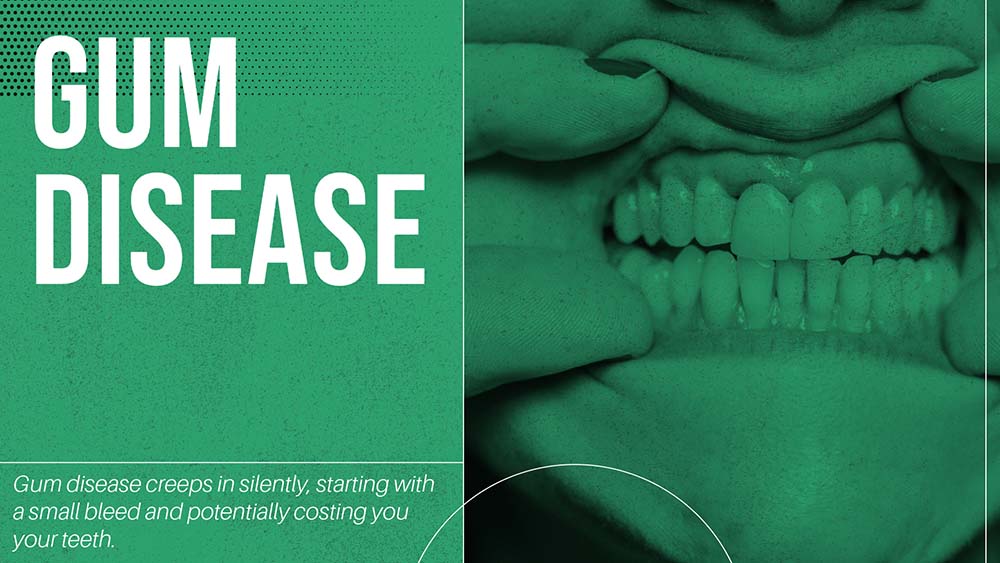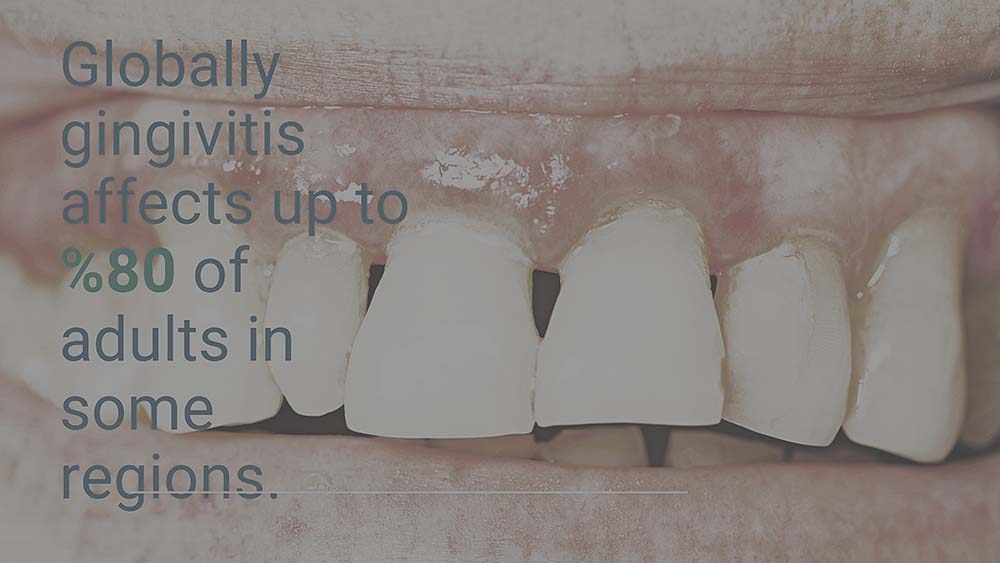Gum Disease.
Only for boundary-breakers .


Beyond the dentristy.
If you've ever lost a tooth or needed a replacement, you might have heard about Gum Disease.
They are a popular solution that not only looks and feels like your natural teeth but also offers long-term benefits. In this page, we’ll walk you through everything you need to know about gum Disease in a simple and easy-to-understand way.
Gum Disease

Your smile is one of the most powerful expressions that make you who you are; but what about the heroes behind the scenes of this smile, your gums? Often overlooked, gums are actually the cornerstone of a healthy mouth and a smile full of self-confidence. However, gum disease can threaten this foundation by progressing like an insidious shadow; first it starts with a small bleeding, then it can even take away your teeth. Moreover, its effects are not limited to your mouth; it can affect your whole body.
The majority of tooth loss in Americans over the age of 65 is attributed to gum disease, according to research findings. No matter if you are dealing with gum disease or not, you need to know how serious this problem is. So let's pay attention to your gums' silent plea and unlock the path to a healthy smile!
Gum disease is the inflammation of our gums. The first stage of this condition is called gingivitis. Gingivitis is characterised by reddening, swelling and sensitivity of the gums. For example, we may notice bleeding when brushing or flossing our teeth. This is usually caused by plaque and bacteria that build up on our teeth. The good news is that gingivitis can be completely cured with early recognition and proper oral care - i.e. regular brushing and flossing.
However, if gingivitis is left untreated, things get serious and the disease progresses to a more advanced stage called periodontitis. In periodontitis, the inflammation is not limited to the gums, but spreads to the bones and tissues that hold our teeth. Our gums begin to recede, our teeth become loose and may even fall out over time. Even worse, bone loss occurs at this stage and this loss is irreversible. So, gum disease is not something to be taken lightly.

This disease is so common worldwide that in some societies it is estimated that 80 to 90 per cent of adults have gingivitis. Gum disease is one of the biggest causes of tooth loss. But its effects are not limited to our mouths. Research shows that gum disease can be linked to serious health problems such as low birth weight, premature birth, diabetes and even heart disease. In other words, our oral health affects our whole body.
In the early stages of gum disease, we usually do not feel a great discomfort. When there is no obvious problem such as toothache, we may not pay much attention to our gums. For example, we may see a symptom such as bleeding gums and think, "I must have used the brush too hard". However, this may be one of the first signs of the disease. Most people only realise that something is wrong when the disease progresses. Therefore, gum disease is a problem that can progress insidiously.
The biggest culprits of gum disease are bacterial plaque and tartar that accumulate on our teeth. Plaque is a sticky layer formed by a combination of food debris, saliva and bacteria. If we do not clean our teeth regularly, this plaque hardens into tartar, i.e. calculus.
Gum disease is not limited to plaque and tartar; other factors also play a role in the emergence of this disease. Here are some of these additional risk factors:

- Smoking and Tobacco Use: Smoking is one of the most serious factors that accelerate gum disease. Moreover, it increases the risk of tooth loss. According to research, tooth loss is 3.6 times more common in male smokers and 2.5 times more common in female smokers.
- Genetic Predisposition: If you have a family history of gum disease, this may increase the chances of it occurring in you. Genetic inheritance plays an important role in predisposition to this disease.
- Hormonal changes: Hormones change during periods such as pregnancy or menopause, which makes the gums more sensitive and facilitates inflammation. It is necessary to pay more attention to oral care at these times.
- Medical Conditions: Some diseases, such as diabetes, increase the risk of gum disease. Especially in diabetic patients, inflammation can be more severe. Autoimmune disorders have a similar effect.
- Medicines that reduce saliva production: Some medicines cause dry mouth and reduce saliva production. Since saliva is a natural preservative that keeps the mouth clean, when it decreases, bacteria multiply more easily and the risk increases.
- Improper diet: Lack of calcium, vitamin D or vitamin C can weaken the gums. In addition, excessive consumption of sugary and carbohydrate foods accelerates the spread of the disease.
- Teeth Clenching: Clenching our teeth puts too much pressure on the teeth and gums. This can cause an existing gum disease to progress faster.
Gum disease may not reveal itself at first; that is, it progresses insidiously. Therefore, it is necessary to check our mouth regularly and pay attention to some signs. Healthy gums are light pink in colour and do not bleed when brushing or flossing. But when things start to go wrong, you start to notice some changes.
In the early stages, your gums may become red, swollen or tender. For example, if you notice a slight bleeding when brushing or flossing your teeth, this is often the first sign of gingivitis. Normally the gums do not bleed, so this should be taken seriously. You may also notice slight swelling where the teeth and gums meet or in the triangular spaces between the teeth. Another clue is bad breath. If you have a persistent bad odour coming from your mouth, this can also be a sign of bacteria and inflammation.
As the disease progresses, the symptoms become more pronounced. Your gums may start to recede from the teeth, which means that your teeth appear to be longer, but in fact your gums are receding. Deep spaces called "periodontal pockets" can form between the teeth and gums. These pockets are a great place for food debris and bacteria to accumulate and become difficult to clean. If you go further, the bones and tissues that hold your teeth in place can become damaged, causing them to wobble or shift. You may even start to feel pain when eating or chewing, which is an indication that the infection and inflammation has spread.
So, when should you worry and run to the dentist? If you are experiencing any of the following conditions, it is a good idea to see a specialist immediately:
- If bleeding occurs continuously when brushing or flossing your teeth,
- If you notice redness, swelling or tender
- If you have a bad odour in your mouth that won't go away,
- If your gums have started to recede,
- If you feel that your teeth are shaking or displaced,
- If you experience pain when eating or chewing.

Gum disease can be an insidious problem that threatens our oral health. It often progresses unnoticed and can lead to serious consequences if not diagnosed in time. When you visit the dentist, the diagnostic process usually begins with a visual examination. The dentist looks carefully at your gums and focuses on a few important details. First of all, the colour of the gums is checked. A healthy gum is light pink, a so-called rose-coloured shade. If your gums appear dark red, this is usually a sign of inflammation. Then look for swelling and bleeding. Do your teeth bleed when you brush or touch them? Do you feel swelling? These may be the first signs of gum disease. Attention is also paid to the texture: Normally, the gums are firm and hard. If they feel soft or loose, this may indicate a problem. Finally, the gums are checked for receding gums. If your gums have receded away from the teeth, this creates an aesthetic problem and may indicate that the disease is progressing.
The dentist also pays attention to some fine details when making a diagnosis. For example, a close look at healthy gums shows a so-called orange peel appearance. This means that the gums have an orange peel-like surface covered with tiny dots and is a sign of good health. If this appearance has disappeared, there may be a problem. Another clue is gum recession. If the gums move away from the teeth, this indicates that the disease is progressing and can lead to tooth sensitivity.
Periodontal Probing Depth Measurement
The next stage of the examination is periodontal probing, perhaps one of the most critical parts. Using a thin instrument called a periodontal probe, the dentist measures the space between the tooth and the gum. This gap is called "pocket depth" and is very important for understanding the severity of gum disease. In a healthy gum, this gap is usually between 1-3 mm. However, if this distance increases to 4 mm or more, this is considered a "pocket" and indicates the presence of disease. The deeper the pocket, the more advanced the disease is. This measurement guides the dentist both in making the diagnosis and in planning future treatment.
Understanding Bone Loss by X-ray
Gum disease can affect not only the gums, but over time also the bones that support the teeth. To detect this, X-rays are taken. The dentist assesses the bone level by looking at the X-rays. If there is bone loss, this indicates a more advanced stage of the disease, i.e. periodontitis. Unfortunately, bone loss is irreversible damage. X-rays are therefore an indispensable tool for understanding the severity of the disease and making an accurate diagnosis.
An Extra Step: Bacterial Tests
In some cases, the dentist may perform bacterial tests for a more detailed examination. These tests are used to determine the type of bacteria in the gum pockets. Understanding which bacteria are causing the disease is particularly useful in complex cases that do not respond to standard treatments. Thus, treatment can be planned in a more targeted manner. However, these tests are not routinely performed in every patient; they are generally preferred in special cases.
Gingivitis and Periodontitis: Which stage are we at?
During the diagnostic process, the dentist also determines the stage of the disease. This is very important for the treatment plan. Gum disease is analysed in two main stages:
- Gingivitis: This is the early stage of the disease and affects only the gums. There may be symptoms such as bleeding and swelling when brushing teeth, but it has not yet damaged the bones. It can be completely cured with good oral care and dental intervention.
- Periodontitis: This is the advanced stage. It goes beyond the gums and damages the bone and tissues that hold the teeth. Bone loss is permanent here and treatment is aimed at stopping further progression of the disease. Early diagnosis is critical to catch the disease at the gingivitis stage, as it is at this stage that a full recovery is possible.
We can basically get rid of this disease that threatens our oral health with two different approaches: non-surgical methods and surgical interventions. Now let's explain them step by step and see what we can do to get healthy gums.
Non-Surgical Treatments: First Intervention
If your gum disease is at an early stage, i.e. you only have symptoms such as redness, swelling or bleeding of your gums (this is called gingivitis), you can reverse the situation with non-surgical treatments. Here is what can be done at this stage:
- Professional dental cleaning: Your dentist or a hygienist will remove plaque and tartar (calculus) that has accumulated on your teeth. This process reduces inflammation in your gums and stops the progression of the disease. When done regularly, it is one of the simplest ways to maintain your oral health.
- Root Surface Smoothing and Detailed Cleaning: A slightly deeper procedure is performed to remove plaque and tartar that goes below the gum line. By smoothing the roots of the teeth, the dentist removes rough surfaces on which bacteria can attach. This speeds up the healing of your gums.
- Medication: Sometimes cleaning alone is not enough. In this case
- Antibiotics: If you have an infection, your dentist may recommend a short course of antibiotics. But beware, using them for a long time can cause bacteria to develop resistance and may not always destroy all bacteria.
- Antimicrobial Mouthwashes: Mouthwashes containing substances such as chlorhexidine reduce the number of bacteria in your mouth and relieve inflammation. However, if you use it for a long time, your teeth may be stained, so it is important to pay attention to the duration of use.
These methods are very effective in the early stages of the disease, but if the disease progresses and progresses to a more serious stage called periodontitis, surgical treatments may be needed. The main surgical treatments applied in gum diseases are as follows.
- Flap Surgery: Your gums are gently lifted and the root surfaces are cleaned. If there is damage to the bone or tissues, these are repaired. The gums are then sewn back into place. This method works very well to remove infection that has accumulated in the deep pockets under the gums.
- Bone and Tissue Grafts: Grafts are used to restore bone or tissue that you have lost due to disease. That is, bone or tissue from elsewhere is placed in the damaged area to keep your teeth more stable. This prevents the teeth from wobbling.
- Guided Tissue Regeneration: A special membrane is placed under the gums. This membrane encourages the growth of bone and tissue cells and helps damaged areas to heal on their own. In a way, it supports your body's repair process.
- Laser Treatment: It is a frequently preferred method recently. Lasers clean infected tissues, destroy bacteria and allow gums to heal faster. Moreover, since it is less invasive, the healing process is generally more comfortable.
Surgical treatments can give very successful results in advanced stages of the disease. However, your dentist should decide which method is suitable for you, because everyone's situation is different.
An important reminder; early intervention is very important in gum diseases. At each late stage, the treatment will become more difficult and the harm to the patient will be greater.
What is the difference between gingivitis and periodontitis?
Gingivitis is the early stage of gum disease; the gums are red, swollen and bleeding but can heal completely. Periodontitis, on the other hand, is the advanced form and damages the bone and tissues that hold the teeth. Bone loss is permanent, teeth may shake or even fall. Early intervention is very important!
Can gum disease be reversed?
Yes, gingivitis can be reversed! With regular brushing, flossing and dental check-ups, your gums will regain their health. In periodontitis, bone loss cannot be reversed, but its progression can be stopped with treatment. Surgical methods can sometimes partially repair the tissues. Pay attention to oral care!
How does gum disease affect overall health?
Gum disease is not limited to the mouth; it can lead to problems such as heart disease, diabetes and premature birth. Inflammation and bacteria can enter the bloodstream and affect the body. Therefore, maintaining oral health also strengthens your overall health. Don't neglect it!
What are the best ways to prevent gum disease?
Good oral hygiene is the basic rule: Brush twice a day, floss, avoid hard brushing. An electric brush can also be effective. Regular visits to the dentist, a healthy diet, quitting smoking and reducing stress protect your gums. Small steps make a big difference!
Is gum disease contagious?
Gum disease is not directly contagious. Bacteria can spread through the mouth, but the disease cannot be passed from person to person. Nevertheless, it is a good idea to avoid using shared objects. The main thing is to focus on your own oral hygiene!
Can children get gum disease?
Yes, children can get gum disease. It usually presents as mild gingivitis, especially if oral hygiene is poor. It can be easily prevented with regular brushing and doctor control. It is important to get into the habit at an early age!
How often should I visit a dentist to prevent gum disease?
In general, one visit every 6 months is sufficient. However, your dentist may recommend a different frequency depending on your oral condition. Regular check-ups catch problems early and keep your gums healthy. Don't skip appointments!
Are there natural remedies for gum disease?
Green tea is a great natural remedy! Drinking or gargling reduces bad bacteria and may even be more effective than chemical mouthwashes. However, it is not a substitute for professional treatment; remember to consult your dentist.
Conclusion:

Gum health is one of the cornerstones of our overall health and cannot be neglected. Therefore, the steps to be taken to prevent gum diseases are vital: Regular visits to the dentist, an effective oral care routine and healthy habits. Remember, healthy gums protect not only your mouth but also the balance of your whole body and give you the happiness of being able to smile with confidence. So, take action now; get your toothbrush, book an appointment and carry your smile into the future. Because every beautiful smile is a mirror of a healthy life!
Timeline to your new smile.
A more beautiful version of your present smile.
Dental Health is our super and only one specialisation.
Dental & oral health is our passion. The goal is a less obvious, natural and more beautiful version of your current smile and oral health.
Bright smile.
Illuminate your world with a smile that shines bright and exudes confidence.
Confidence booster.
Unlock your true potential with a smile that boosts your confidence.
Pure & perfect.
Experience the pinnacle of dental perfection with avita dental treatments.









